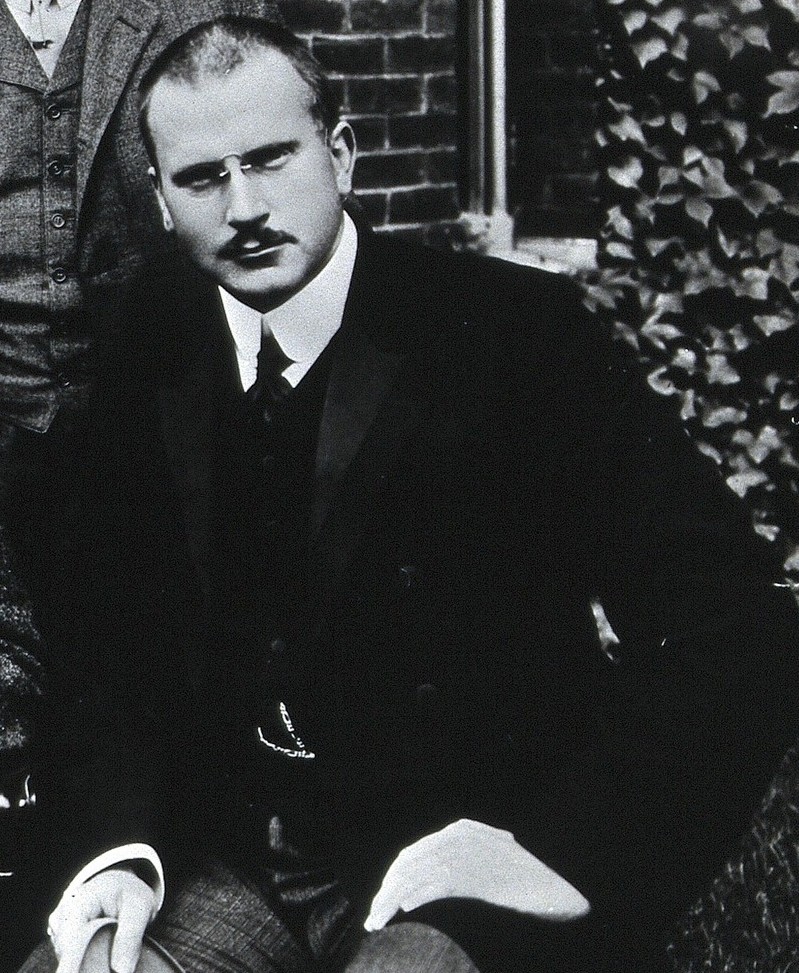
Carl Gustav Jung. Source: Cropped from a group photograph with Freud and others in the Wellcome Collection. Attribution 4.0 International (CC BY 4.0).
Born in Kesswil, Switzerland, Carl Gustav Jung (1875-1961) first encountered the work of Sigmund Freud in 1902. As a child, Jung took after his reclusive mother, Emilie, who was prone to seeing "spirits," reporting early experiences that included feelings of "a headless body" and other unusual phenomena. His sister, Johanna Gertrud ("Trudi") was born when Jung was nine; she would later act as his secretary.
Following the family's strongly Protestant ministerial tradition, Jung initially thought of becoming a preacher. After forays into archaeology and philosophy at the University of Basel, he finally undertook medical studies there in 1895. In 1900 he moved to Zürich in order to study at the Burghölzli (University) Psychiatric Hospital under the direction of Eugen Bleuler.
By 1902 both men were reading and studying Freud's early works on psychopathology. In February 1907, after a preliminary exchange of letters and books, Jung visited Freud's Berggasse apartment where he was an immediate success with the family, including the then twelve-year old Anna Freud. Over the next six years, an extensive correspondence developed between the two men (McGuire 1974, no page). Though the relationship later dissolved, Anna Freud faithfully guarded her father's share of this correspondence and released it at the appropriate time. (Her own published references to Jung were nevertheless rare and delayed by more than fifty years; see Dyer 1983, p. 8).
Jung found little common ground with the Vienna psychoanalysts on the nature of libido. Whereas to them it was a sexual drive, biological and largely unconscious, Jung considered it an entity of an archaic unconscious, partly historic and manifesting in a universal symbolic system made up of archetypal images. It remains unclear whether it is Freud's libido or Jung's collective unconscious that more influentially shapes psychological life; clarification may well depend on on-going bilateral comparisons with a view to a new synthesis. The brief bibliography appended below provides a start, as these complex ideas reward thorough study, thought and application to particular life experiences.
Related Material
- Some Basic Jungian Concepts
- Basil, Lord Henry, and Wilde: A Jungian Aproach to the Picture of Dorian Gray
- Jung's Extraverted Intuition Type and Fear of the Feminine in the Picture of Dorian Gray
- The Effective Protagonist (a Jungian psychological interpretation)
Bibliography
Dyer, Raymond. Her Father’s Daughter. The Work of Anna Freud. New York and London: Jason Aronson, 1983.
Jung, C. G. Psychology of the Unconscious. Trans. Beatrice M. Hinkle. New York: Moffatt, Yard & Co. New York. 1916.
_________. Psychologische Typen (Psychological Types). Zürich: Rascher Verlag, 1921.
_________. Archetypes and the Collective Unconscious. Vol. 9, part 1 of Collected Works of C. G. Jung. Trans. R.F.C. Hull. Princeton, NJ: Princeton University Press, 1969.
Read, Herbert et al., eds. The Collected Works of C. G. Jung. Trans. R.F.C. Hull. 20 vols. London: Routledge & Kegan Paul, 1953-80.
Brome, Vincent. Jung. New York: Atheneum, 1978.
Wehr, Gerhard. Jung: A Biography. Dorset: Shambhala, 1987.
Created 24 February 2021